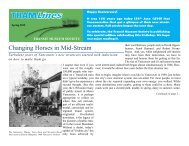You also want an ePaper? Increase the reach of your titles
YUMPU automatically turns print PDFs into web optimized ePapers that Google loves.
(Continued from page 5)<br />
of a smaller but related model doesn’t<br />
include one:<br />
Youtube<br />
Motive power could be provided by either<br />
diesel or gasoline powered engines<br />
and one assumes, given the company’s<br />
decision to stay with gasoline postwar,<br />
that the BC Electric’s vehicles were gasoline<br />
powered. Both engines were manufactured<br />
by Hercules Manufacturing<br />
Company of Canton, Ohio, though the<br />
gasoline version incorporated several<br />
Fageol-inspired modifications and was<br />
known as Fageol-Hercules.<br />
This choice of engine supplier may appear<br />
surprising since Fageol and Hall<br />
Scott --which also produced gasoline engines--<br />
were under common ownership.<br />
The answer lies in the complex web of<br />
takeovers, buyouts and financing that<br />
happened in the late 1920s.<br />
The Fageol brothers, having sold their<br />
company to American Car & Foundry,<br />
became disillusioned with their position<br />
within the new combine. They left to design<br />
and build a new transit bus with<br />
‘twin-engines’.<br />
The new company was known legally as<br />
the Twin Coach Co. Within a few years,<br />
American Car & Foundry would cease<br />
using the Fageol name, it would begin<br />
design of the famous Brill range of transit<br />
and intercity buses, and, after WW2,<br />
Twin would try to compete against it<br />
with a new ’Bomber-nose’ bus.<br />
Incidentally, in this later Twin Coach<br />
design, the engine would return to its<br />
mid-ship position; some buses would<br />
even be produced with twin-engines (including<br />
some for BCER), and most<br />
would be gasoline or propane powered.<br />
The Twin Coach company recognized<br />
the supremacy of the diesel engine —<br />
championed by GMC— much too late.<br />
It tried a joint venture with Canadian<br />
Leyland to fit one its’ diesels below floor<br />
in much the same way as CCF/Brill’s<br />
English-sourced AEC.<br />
But it was not a success, failed to arrest<br />
the downward trend in orders, and eventually<br />
Twin Coach would be absorbed by<br />
GMC’s only real competitor in the sixties<br />
and seventies- Flexible.



